|
|
|
|
|
This page last updated October 20, 2024 |
In recent years, many states and local jurisdictions have started implementing a variety of "innovative" or "novel" intersection designs to help improve traffic flow and safety at a relatively low cost. That trend has made its way to Texas and San Antonio.
 What is a signal phase? A signal phase is the green time assigned to a specified movement or collection of simultaneous movements in a traffic signal cycle. In other words, when the signal is green for a specific movement (straight through, left turn, etc.), that's a signal phase. When it changes to red and another movement gets a green signal, that's another phase. The complete rotation through of all of the phases is a cycle. |
Left turns are also the most dangerous maneuver at most intersections, especially those with no signals or with permissive left turn signals.
To solve this problem, a number of unconventional intersection designs have been developed over the years both in the US and abroad. These include the following:
- Roundabouts
- Displaced Left-Turn (DLT) intersections
- Diverging Diamond Interchanges (DDI)
- Single-Point Urban Interchanges (SPUI)
- Restricted Crossing U‑turn (RCUT) and Median U‑turn (MUT) intersections
To date, all of the above except the Median U‑turn have been implemented in San Antonio or are planned; these are described in more detail below. There are several more designs that aren't in use or planned for San Antonio including the "Jughandle", "Center Turn Overpass", "Michigan Urban Diamond" (similar to but different than the Median U‑turn), "Echelon", "Raindrop", and "Parallel Flow"; you can read all about these at the "Alternative Intersections/Interchanges Informational Report" link at the bottom of this page.
In San Antonio and most of the US, roundabouts have been typically limited to low-volume intersections (usually in lieu of four-way stops or simple traffic signals) whereas the other designs are intended for high-volume intersections. SPUIs are typically only used at intersections with freeways, while the others can be used at both freeway and arterial intersections (although RCUTs and Michigan Lefts are typically not used at freeway intersections).
Each of these intersection designs deal with left turns in different and unconventional ways in order to either eliminate the green time required for them or combine those phases with other phases. Doing so means fewer phases per cycle, which allows more green time for the remaining phases. This results in more throughput and less waiting, and therefore reduced congestion. They also are generally safer.
|
ADVERTISEMENT |
Roundabouts
A roundabout works by providing a continuous, one-way circular flow of traffic through an intersection around a central island. Because traffic entering a roundabout is not required to stop if there is no conflicting traffic, the roundabout can move more traffic over the same period of time than a four-way stop or signal. Furthermore, unlike a conventional intersection, the space in a roundabout and its flow allows a vehicle on all four approaches to enter and traverse the intersection simultaneously, again helping to move more traffic. Studies have consistently shown a significant reduction in delays — in some cases up to 90% — and typically a 50% or so reduction in vehicle stops and a 30 to 50% increase in capacity at intersections that have been converted to roundabouts.
Additionally, the curved roads in a roundabout eliminate the possibility for T-bone and head-on collisions and reduce the speed of traffic through the intersection, thus improving safety. Indeed, studies have shown roundabouts to be much safer than conventional intersections. The stats often cited are a 90% reduction in fatal crashes, 75% reduction in injury crashes, 40% reduction in pedestrian and bicycle crashes, and a 37% reduction in overall crashes.
While at one point roundabouts were novel, today most drivers are familiar with them as they have proliferated across the driving landscape. There are now about 30 roundabouts in the San Antonio area, with the oldest dating to 1953, and over 800 in Texas. San Antonio's first contemporary roundabout was the McCullough Ave./Olmos Dr./El Prado Dr. intersection in Olmos Park, which was built in 1996. Another early roundabout retrofit locally was at Blanco Rd. and Fulton Ave. where it replaced a traffic signal in 2007. It was met with much skepticism, criticism and predictions of mayhem and carnage because of the adjacent elementary school, none of which materialized (which is typically the case).
Double roundabouts (sometimes referred to as "dumbbells" or "dog bones") are used in many places at freeway exits and entrances and are being considered locally for a few access road intersections in the New Braunfels area.
As mentioned earlier, roundabouts are typically limited to low-volume intersections such as in neighborhoods, shopping centers, or on minor arterials, usually in lieu of four-way stops or two-phase traffic signals. Roundabouts lose their effectiveness under heavy traffic loads and therefore are inappropriate on most major roads.
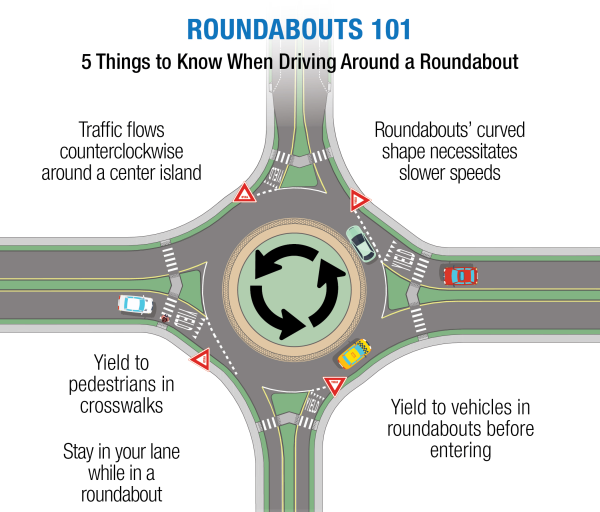
Once in the roundabout, keep moving — do not try to be "helpful" and stop to let a driver approaching from the right to enter. Doing so is the equivalent of stopping at a green light; drivers behind you won't expect it and may rear-end you, not to mention that stopping unnecessarily gums-up the works.
To leave the roundabout, watch for your exit. Just before you exit, signal right. Then veer right to leave the roundabout keeping an eye out for any pedestrians that may be crossing or preparing to do so. If you miss your exit, just go around again.
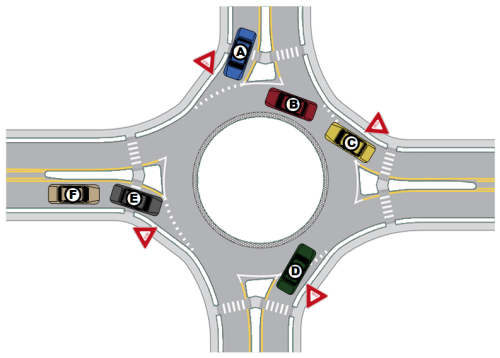
B: This driver should continue moving and NOT stop to let driver A enter the roundabout.
C: This driver is entering properly as there is nobody nearby to yield to.
D: This driver is also entering properly as there is nobody nearby to yield to.
E: This driver is stopping unnecessarily because they think they have to stop if a vehicle is anywhere in the roundabout or even just getting ready to enter it.
F: This driver is pretty annoyed with the driver of vehicle E and nearly rear-ended them because driver E stopped unexpectedly and unnecessarily.
|
|
Wikipedia - Roundabout https://en.wikipedia.org/wiki/ |
|
|
Cheddar - Why the US Hates Roundabouts https://www.youtube.com/watch?v=AqcyRxZJCXc |
|
|
CNBC - Roundabouts Are Safer. So Why Does The U.S. Have So Few Of Them? https://youtu.be/atORPw-w83I?si=VIILJvXD5BNiHfsf |
|
|
Insurance Institute for Highway Safety - Roundabout Q&A http://www.iihs.org/iihs/ |
|
|
Washington State Department of Transportation - Roundabout benefits https://www.wsdot.wa.gov/Safety/ |
|
|
Federal Highway Administration - Roundabouts and Mini Roundabouts Safety https://safety.fhwa.dot.gov |
Displaced Left-Turn (DLT) Intersection
A DLT increases the throughput of an intersection by allowing traffic headed in both directions on a road (including left turns) to all move simultaneously (or nearly so). This is accomplished by diverting ("displacing") the left-turning traffic to the opposite side of the roadway several hundred feet upstream from the near-side of the intersection. This displacement moves most or all of the left-turning traffic across and out of the way before opposing through traffic reaches the crossover location, thus minimizing or even eliminating the time through traffic has to wait for that opposing left-turning traffic. The displacement also provides a short overlap period that permits left-turning traffic to be released even while the intersecting road still has a green light.
This "continuous flow" of traffic in multiple directions means that only one green phase is needed for both directions on the major road instead of the two or three phases required at the conventional intersections. The time saved from having only one phase can then be redistributed to extend the green time for all approaches, thus moving more traffic through the intersection on each cycle without having to increase the overall cycle length.
DLTs can be used at both regular intersections (i.e. the intersection of two arterials), or at intersections of an arterial with a freeway. In San Antonio, the existing and planned DLTs are the latter, but there is an arterial-to-arterial DLT in Austin.
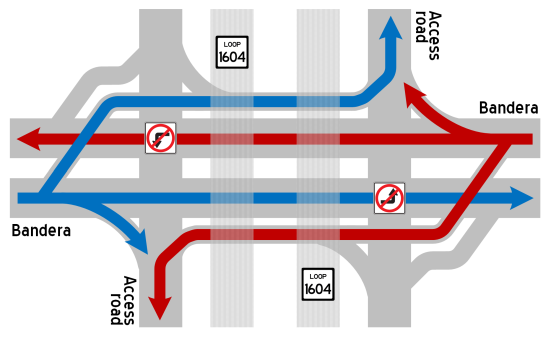
Safety has also generally improved at DLT intersections studied with serious crashes decreasing 34% at the Baton Rouge location (total collisions were down 25%) and crashes at or near a DLT in Utah were reported to have decreased a whopping 60%. Crashes at the Bandera/1604 intersection decreased 44% during the first nine months of operation. A further review in 2022 showed that, despite traffic having returned to pre-COVID levels, crashes at Bandera and Loop 1604 were less than half of what they were before the DLT.
- SH 16/Bandera Rd. and Loop 1604 (in operation since 2019)
- I‑35 and FM 306 (New Braunfels) (partial, in operation since 2022)
- Loop 410 and WW White Rd./Cornerway Blvd. (proposed)
- US 281 and Basse Rd. (partial, proposed)

|
For a deeper dive on how a DLT works, see the Bandera and Loop 1604 DLT page. |
|
|
Wikipedia - Continuous-flow Intersection https://en.wikipedia.org/ |
|
|
TXDOT - Continuous Flow Intersections Fact Sheet http://ftp.dot.state.tx.us/ |
|
|
FHWA - Displaced Left Turn Intersection Informational Guide https://safety.fhwa.dot.gov/ |
|
|
DLT Case Study - Bangerter Highway in Salt Lake County (Utah) https://www.youtube.com/ |
|
ADVERTISEMENT |
Diverging Diamond Interchange (DDI)
A DDI increases the throughput of an intersection by shifting all traffic on the cross street at an interchange over to the left side as it passes through the interchange. Doing so then allows two movements that would normally be conflicting to go at the same time. For example, the traffic from one access road can proceed at the same time that traffic coming on the cross street from its left is also moving. This overlapping eliminates one of the two signal phases required for those movements in a conventional intersection, making the signals much more efficient by allowing more traffic to move through the intersection in the same amount of time.
DDIs also improve safety by reducing the number of potential crash points from 26 to 14 with the worst type (side-angle collisions) reduced from 10 to just two. Additionally, a DDI physically prevents drivers from turning the wrong way onto the access roads, thus helping to prevent head-on collisions on the freeway.
The major drawback of a DDI is that it does not allow straight-through traffic on the access roads/ramps. If this is needed, it can be facilitated with a bypass roadway either above or below the intersection.
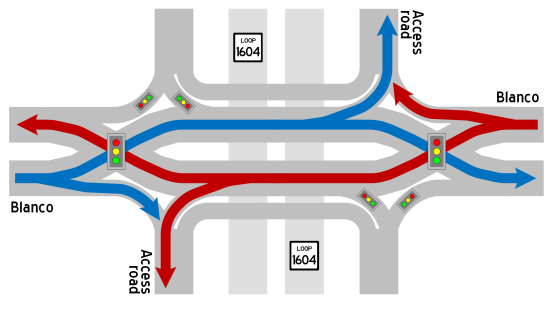
- Blanco Rd. and Loop 1604 (under construction)
- Jones-Maltsberger Rd. (South) and US 281 (proposed)
- SE Military Dr. and I‑37 (proposed)
- Culebra Rd. and Loop 1604 (proposed)

|
For a deeper dive on how a DDI works, see the Blanco and Loop 1604 DDI project page. |
|
|
Wikipedia - Diverging Diamond Interchange https://en.wikipedia.org/wiki/ |
|
|
Alternative Intersections - Diverging Diamond Interchanges http://www.divergingdiamondinterchange.org/ |
|
|
The Diverging Diamond Interchange Website https://www.divergingdiamond.com/ |
|
|
TXDOT - DDI Fact Sheet (created for FM 1431 project but applies generally) http://ftp.dot.state.tx.us/ |
|
|
FHWA - Diverging Diamond Interchange https://safety.fhwa.dot.gov/ |
Single-Point Urban Interchange (SPUI)
A SPUI elongates a standard freeway-arterial intersection so that the two intersections typically formed by the access roads on each side of the freeway are instead compressed into a single intersection located between the access roads. To do this, the access road approaches are angled inward so that the left turn movements can pass-by each other like they would at a typical surface street intersection. This allows the opposing left turn movements on each axis of the intersection to proceed simultaneously like they do in a typical intersection, thus reducing the number of signal phases required from four to three. Right-turns still take place at the same location as they do in a conventional intersection. However, with a SPUI, there is no straight-through traffic on the access roads. If this is needed, it can be facilitated with a bypass roadway either above or below the intersection.
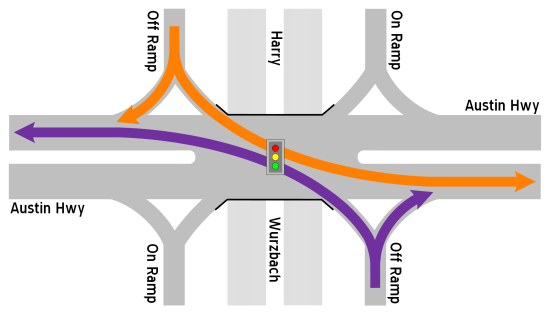
- Austin Highway and Harry Wurzbach Rd. (in operation since 2023)
- NW Military Hwy and Wurzbach Pkwy. (proposed but subsequently dropped from consideration)

|
For a deeper dive on how a SPUI works, see the Austin Highway and Harry Wurzbach SPUI page. |
|
|
Wikipedia - Single-point urban interchange https://en.wikipedia.org/ |
|
|
TXDOT - Single Point Urban Interchange Fact Sheet http://ftp.dot.state.tx.us/ |
|
|
FHWA - Alternative Intersections/Interchanges Informational Report https://www.fhwa.dot.gov/ |
Restricted Crossing U‑turn (RCUT) and Median U‑turn (MUT) intersections
These are essentially two versions of the same concept. Both use U‑turns on either side of the main intersection to facilitate some or all left turns. In the MUT, there are no left turns at all on either roadway at the main intersection, while in the RCUT, there are left turns from the primary road but no left turns or straight-through traffic on the cross street.
RCUT intersections are also known as "Superstreets", and MUT intersections are also known as "Michigan Lefts".
Below are simplified schematics that show the allowed maneuvers in each type of intersection:
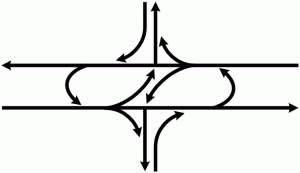 |
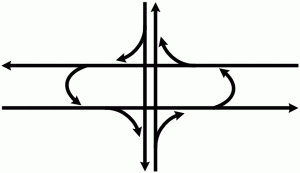 |
|
RCUT ("Superstreet") traffic flow
|
MUT ("Michigan Left") traffic flow
When both roadways have heavy traffic volumes, U‑turns can also be provided on the cross street.
|
 RCUT ("Superstreet") traffic flow
|
| |
 MUT ("Michigan Left") traffic flow
When both roadways have heavy traffic volumes, U‑turns can also be provided on the cross street.
|
In both cases, the left turns from the cross street are moved to the U‑turn crossovers, thereby eliminating that time from the signal cycle.
In the Michigan Left, the left turns from the primary road are also moved to the U‑turns, so that time is also eliminated, resulting in a simple and very efficient two-phase signal at the main intersection.
In an RCUT, straight-through traffic on the cross street is also moved to the U‑turns. This has the benefit of allowing the large single intersection to be broken into two smaller independent intersections (one on each direction of the primary road), each with their own two-phase signals. This allows each direction of the primary road to be timed and coordinated independently from each other, resulting in even more efficiencies.
There are no MUT/Michigan Left intersections in San Antonio, although one was evaluated for the NW Military Hwy./Wurzbach Pkwy. intersection. However, there are multiple RCUT intersections in operation or planned:
- SH 16/Bandera Rd. between Loop 1604 and FM 1560 South (Helotes) (FM 1560 South in operation since 2018; remaining intersections in operation since 2024)
- SH 16/Bandera Rd. between FM 1560 South and Triana Pkwy. (Helotes) (proposed)
- SH 16/Bandera Rd. between Loop 410 and Loop 1604 (proposed)
- US 281 between Encino Rio and Marshall Rd. (in use from 2010 until replaced by a freeway in 2021)
- Loop 1604 between New Guilbeau Rd. and Shaenfield Rd. (in use from 2011 until replaced by a freeway in 2016)
- Loop 1604 between US 90 and Macdona Lacoste Rd. (construction expected to start in 2026)

|
For a deeper dive on how RCUT intersections work and the history of their use locally, see the Restricted Crossing U‑turn intersections page. |
|
|
Wikipedia - Superstreet https://en.wikipedia.org/ |
|
|
Pape-Dawson "Superstreets in Texas" presentation https://drive.google.com/ |
|
|
Utah DOT - ThrU-Turn Follow-Up (Excellent video showing outcome of a Michigan Left project in Draper, Utah) https://youtu.be/UDbP7NiAMHE |
|
|
Federal Highway Administration - RCUT/MUT intersections https://highways.dot.gov/ |
|
|
An Update on Superstreet Implementation and Research (Report) http://www.teachamerica.com/ |
|
|
An Update on Superstreet Implementation and Research (Presentation) https://pdfs.semanticscholar.org/ |
|
|
NC Department of Transportation presentation on superstreets (Excellent explanation of all aspects of superstreets) https://www.partnc.org/ |
Other sites of interest
|
|
TxDOT - Innovative Intersections https://www.txdot.gov/about/ |
|
|
Federal Highway Administration - Alternative Intersections/Interchanges Informational Report https://www.fhwa.dot.gov/publications/ |
|
|
Federal Highway Administration - Alternative Intersections/Interchanges: Informational Report https://rosap.ntl.bts.gov/view/ |
|
|
Virginia Department of Transportation - Innovative Intersections and Interchanges https://virginiadot.org/ |
|
|
University of Maryland ATTAP - Unconventional Arterial Intersection Design http://attap.umd.edu/2015/ |
|
|
CityLab - Could These Crazy Intersections Make Us Safer? https://www.citylab.com/ |

